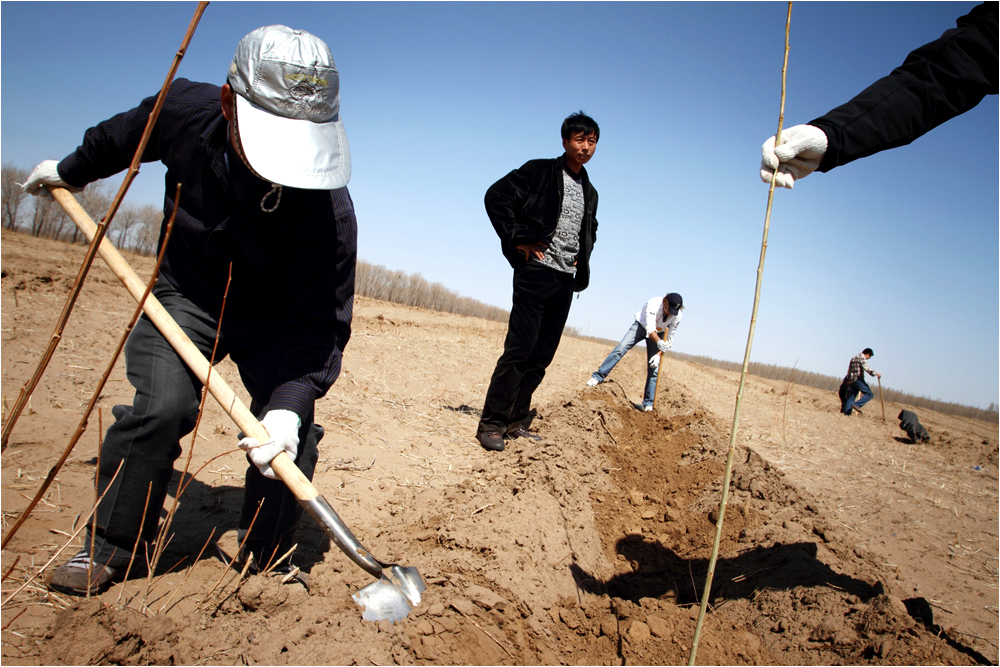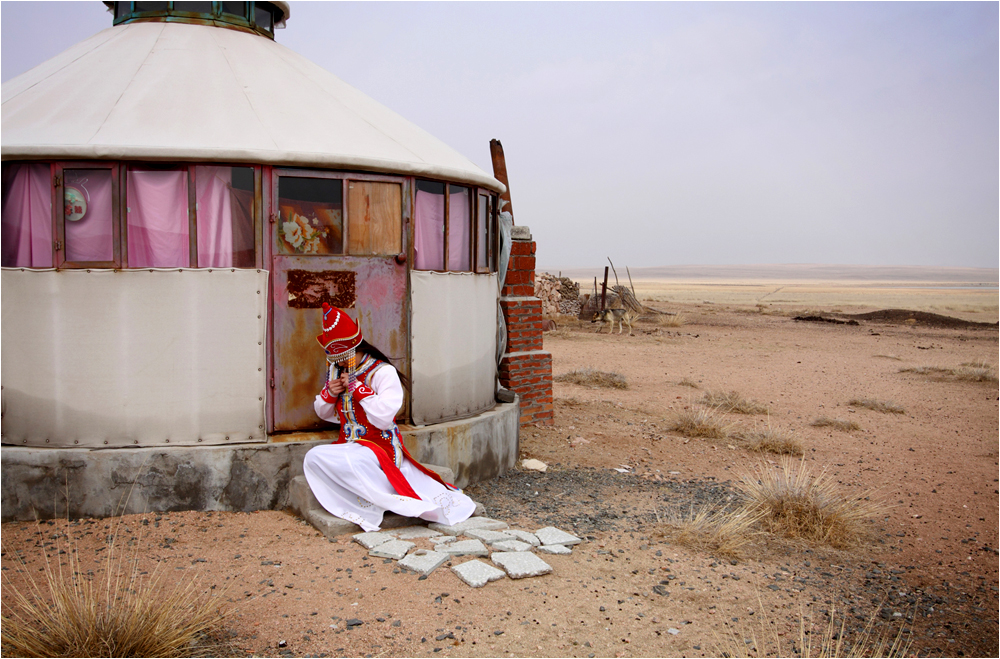Circle of Blue revisits sea of dying grass and blowing sand in northern China.
|
|
|
A tourist tries on traditional Inner Mongolian dress on the degraded grasslands.
|
Soaring temperatures, brutal winds and deeper droughts are becoming the new norm in Inner Mongolia, the Chinese Autonomous Region distinguished by a sea of grass that climate change is steadily turning into an ocean of dust.
Two years ago Circle of Blue published “Reign of Sand,” the most thorough online multi-media account of the causes and consequences of the perilous “Yellow Dragon,” the choking spring dust storms that start in Inner Mongolia and sweep across China, affecting breathing and manufacturing as far away as Japan and both Koreas.
This week, Circle of Blue updated its special report and found that conditions are no better in some places, and that the deterioration is accelerating in most of Inner Mongolia, an arid and nearly treeless plain of about half the size of the United States.
In March, China’s capital city, Beijing, was coated by a layer of orange dust from a sandstorm that originated from the deserts of Inner Mongolia. In June, several provinces in northeast China issued an orange alert, the second highest level for heat.
Drought gains a stronger grip on the region, likely the consequence of climate change, according to a report by McKinsey & Co. If the drought persists, nearly 13.8 million metric tons of Chinese crops could be lost by 2030, according to the report. Last month, the UN secretary general called for the international community to renew its commitment to tackle desertification and land degradation.
 |
|
Tree-planting in KunlunQi in eastern Inner Mongolia by the NGO Roots & Shoots whose aim is to plant 1 million trees in the area to combat desertification. 2010 |
Over Grazing, Over
Population, Over Everything
Sean Gallagher,
a British photojournalist working on
a grant from the Pulitzer Center on
Crisis Reporting, spent much of 2009
documenting desertification in Inner
Mongolia, He said in an interview
this month with Circle of Blue that
overgrazing, overpopulation, drought
and increased demand for groundwater
threaten the health and livelihood
of the nearly 24 million residents
of Inner Mongolia and hundreds of
million outside of Inner Mongolia.
“For many city residents, the only acknowledgment that there is a problem with the nation’s deserts comes in the spring when sandstorms descend on the capital,” Gallagher said.
The recent sandstorms that inundated Beijing in March prompted the authorities to issue a level-five pollution warning–signaling that it is hazardous to breathe–that closed parks and open spaces to morning exercise. Meanwhile, spring storms in northern Chinese provinces west and east of Inner Mongolia proved disastrous.
A storm in April in the northwest Shandong province, China’s fruit and vegetable production base, killed three people, damaged the property of 1.5 million residents, caused 4,000 homes to collapse and ruined several thousand greenhouses. That same month, a sandstorm hit Qinghai in the northwest part of the country, while the Hexi Corridor experienced its worst sandstorm in 9 years.
|
|
| Traditional life has long since dissapeared in Inner Mongolia. Traces of nomadic life only remian hanging on the wall of local farmers' homes. 2009 |
Forests and
Abandoned Land
“As the effects of desertification
have increased, farmers in rural
areas have been forced to abandon
their land. Levels of rural poverty
have risen and the intensity of
sandstorms, which batter northern
and western China each year,
continue to intensify,” Gallagher
said.
The changing climate is a big factor, scientists say. The regional meteorological bureau reports that almost 40 percent of the region’s land area is experiencing drought. Another recent McKinsey report also found that drought decimated 4.5 million hectares in eight provinces in northern China in early 2009. In August of the same year, drought caused the destruction of 10 million hectares of crops and dried up the drinking water of 7 million people in central and northern China.
In April the drinking water of more than 250,000 people in Chifeng City in Inner Mongolia grew short, according to local news reports. This year Chifeng experienced the worst drought in a decade as 62 percent of the city’s small and mid-sized reservoirs dried up, and the volume of major rivers declined by 77.4 percent.
“Water scarcity is a problem, which both rural and urban dwellers are starting to feel acutely,” Gallagher said. “Dropping water tables in some rural areas has led to the complete disappearance of underground water and many reservoirs which supply water to the major cities are exhibiting reduced levels.”
Aware of the ramifications of failing to act, China has aggressively adopted campaigns like the Sloping Land Conversion program, which rehabilitates degraded and desertified farmland. The central government also is pursuing reforestation. By the end of 2009, according to CCTV, the state television, China had reached its goal of covering 20 percent of the nation’s land with trees. Late last year, President Hu Jintao committed the country to add 40 million hectares of trees by 2020.
Molly Walton is a reporter for Circle of Blue. Reach her at mollyw@circleofblue.org.








